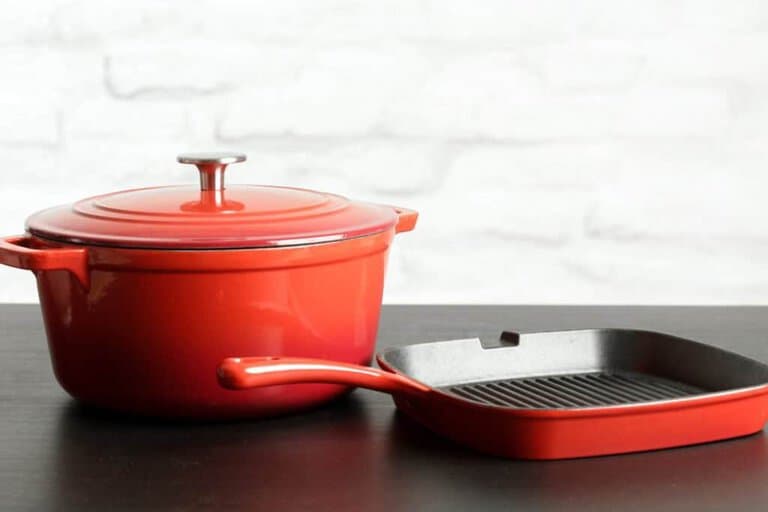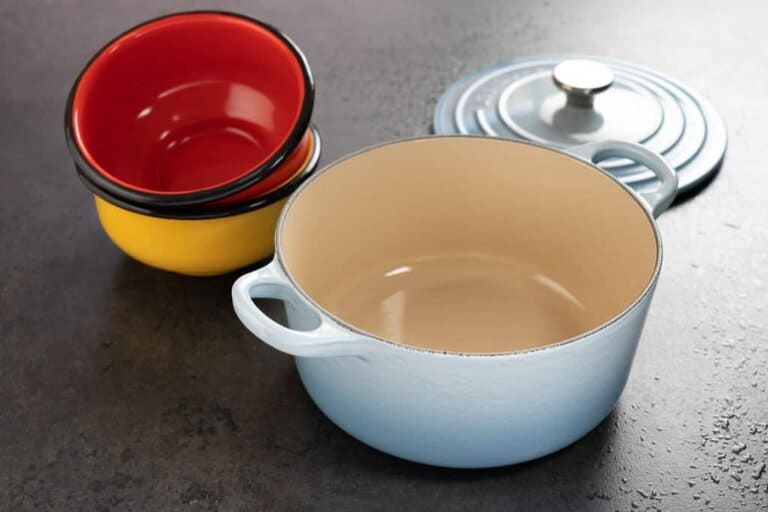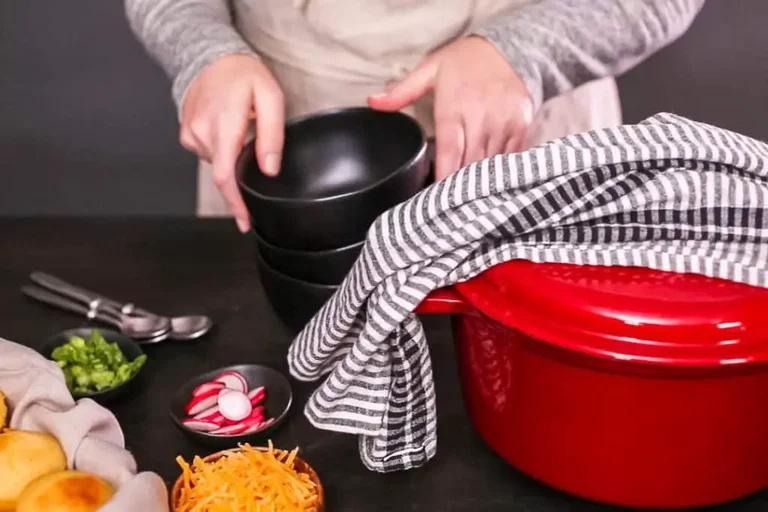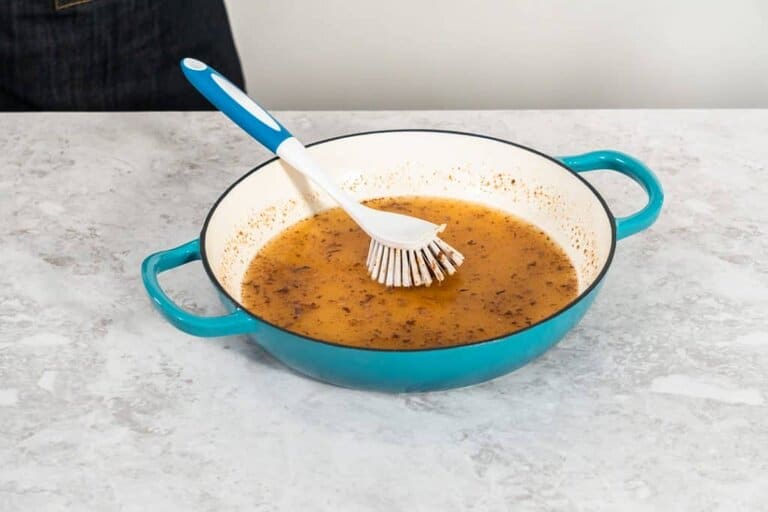Food starts sticking to the enameled cast iron after some time. Use oil with a high smoking point to season your enameled cookware. Keep the pans safe from temperature shock and clean your cookware using a soft sponge.
The enamel coating on cast iron cookware makes it semi non-stick and non-reactive. This helps you cook things in them with ease. Enamel is certainly not as smooth as a non-stick coating but enameled cast iron cookware is better than regular cast iron pots and pans.
Despite the enamel coating, food sticks to the cast iron pans. Over the passage of time, the enamel coating on your cast iron pots and pans wears down and starts to stick. When improper use, heat, different kinds of food, etc. all come together, you get a sticky residue that builds up as time passes.
This makes cooking with your enameled cast iron difficult. Here’s what you can do to keep your favorite meals from sticking to the enamel.

Why Does Enameled Cast Iron Cookware Stick
Let’s take a look at the reasons why your enameled cast iron cookware starts to stick.
Unseasoned Cookware
Enamel isn’t completely non-stick in nature – it is semi nono-stick. You need to season your raw cast iron cookware first to make it non-stick. It will require a little maintenance and upkeep but you will not have any difficulties while cooking.
High Temperature
When you are cooking in an enamel pot, you have to take care that the flame isn’t very high. If you cook at high temperatures, you will have sticking issues. Moreover, if you don’t use enough oil or grease, food will start to stick in the pan.
Ingredients
There are certain food and ingredients that stain your favorite enameled cast iron pans. These food items will caramelize and stick to the pan. They will burn very easily and quickly. A few of these ingredients are:
- Sugary Sauces
- Honey
- Garlic
- Onions
- Wine
- Tomatoes
Apart from the type of ingredients, the cooking process itself is also a factor when it comes to stains on your cookware. If your cookware is light-colored, it will absorb the color of the food that you cook in it.
The food particles will stick to the pan and burn as well. Even when you remove the food and clean the pot, the discoloration will remain. It doesn’t mean that you can’t cook these food items at all in the pan – it means that you have to be very careful while doing so.

Cooking Utensils
The cooking utensils you use with your enameled cast iron cookware should ideally be silicone, plastic, or wooden. Metallic utensils will chip or scratch the enamel. This will act as a base for all other particles, oil, sticky buildup, etc.
How to Keep the Food from Sticking to the Enameled Cast Iron
Here are two ways to keep your enameled cast iron safe and sound.
Season the Cookware
Enamel is not non-stick in nature. Therefore, you have to season the cookware with oil generously before each use. People think that seasoning your pots and pans is a difficult process.
This isn’t the case. It only takes 30-45 mins to season the cookware. Use oil on the bottom as well as the sides before you heat the pan up. This will keep the food from sticking to the enamel.
Temperature Maintenance
When you are using cast iron pots and pans, you need to remember the heat output properties of cast iron. It heats up slowly – when it is hot, it tends to retain heat for a long period of time. Before you put food inside the cookware, you need to heat it properly.
Firstly, put water or oil in the pan. Be generous. Heat your pan over low flame. You can slowly increase the flame to medium if you are going to fry, sauté, or sear your food. Even at low flame, the oil will become hot so when you place your ingredients in the pan, you have to be ready for splatter.
After you have placed the food inside the pan, you raise the heat to your desired level. If the pan gets too hot, simply reducing the heat will not do the job. You have to turn the heat off entirely and remove the pan from its burner.

Stir the food to avoid sticking as your pan cools down a bit. Another golden tip – don’t let the food dry on the pan. If you do that, it will make your cleaning job very hard. Remove all of the food from the pan as soon as you are down cooking.
Once the pan cools down, you can soak it in water. Never use cold water on a hot pan – it will cause thermal shock and damage your pan.
How to Remove Stains from Enamel
Your pans and pots will stain lightly even if you use them gently, with a lot of love and care. Make sure that you don’t use abrasive cleaners for your enamel cast iron cookware. Think what would happen to your car if you started cleaning it with steel wool!
Things You Will Need
- Dishwashing Liquid
- Sponge
- Baking Soda
- Lukewarm water
Method
- Fill your sink with lukewarm water
- Take 2 tbsp. dishwashing soap.
- Add it to the sink. Mix thoroughly until suds are formed.
- Soak the enamel pan in it for 15 minutes.
- Use a soft sponge to remove as many of the burnt particles as possible.
- Take the pan out and wash it with clean water.
- If the discoloration is still there, take 3 tbsp. of baking soda and mix it with 2 cups of water.
- Let this mixture simmer for 10 minutes in the pot.
- Turn off the heat and allow the pot to cool down.
- Clean the pot with soapy water again.
- If the stain still persists, repeat until you get your desired results.

Just because the cast-iron pot has an enamel coating, it doesn’t mean it will not rust. After you have washed the pot, you need to dry it thoroughly with a soft towel. You can also place your cast iron cookware in a warm oven to dry it completely before you store it.
Benefits of Enamel Pans
Here are the reasons why enamel pans are very popular.
- Enameled cast iron pans don’t retain smells and aromas. They don’t hold flavors and don’t alter the taste of your food as well.
- You can wash the enameled cast iron pans easily. With a little soap and water, they start shining again!
- As long as the enamel coating remains intact, your pans will not rust.
- Enameled pans conduct heat exceptionally well. They also distribute heat evenly which ensures your meals are cooked uniformly.
- They come in a variety of styles and colors. You can easily select one that matches your décor.
- Since they are long–lasting, you can pass them on as heirlooms to your kids.
FAQs for Enameled Cast Iron Sticking
What is Enamel?
When you fuse powdered glass and metal using intense heat, you get a material known as enamel. As the powdered glass melts, a continuous layer of enamel starts to form. The high temperature gives it durability.
How is an enamel pan made?
Firstly, the sheet metal is cut down in the shape of individual rings. Then, at high pressure, these rings are pressed and they form the body of the pan. After the body is ready, a smooth coating of enamel is applied which gives the pan a lustrous and smooth surface.